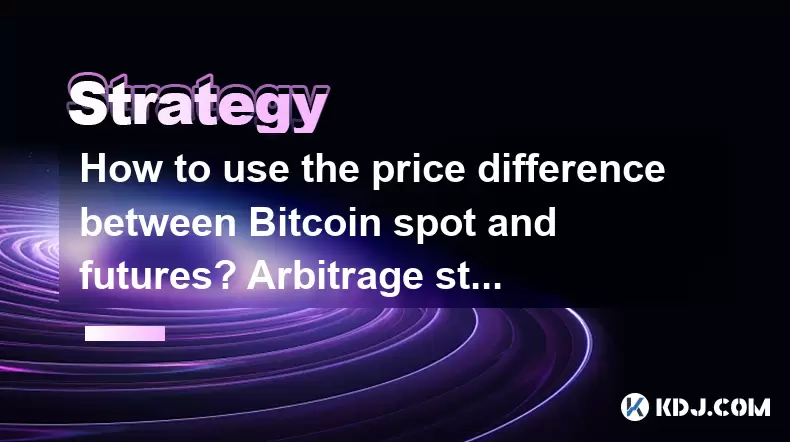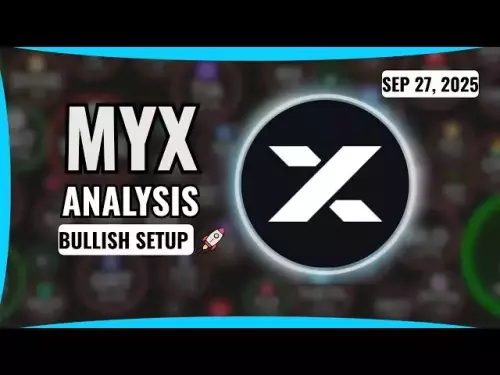-
 bitcoin
bitcoin $109523.663807 USD
-0.13% -
 ethereum
ethereum $4019.526508 USD
2.06% -
 tether
tether $1.000482 USD
0.00% -
 xrp
xrp $2.776815 USD
0.18% -
 bnb
bnb $958.942396 USD
0.12% -
 solana
solana $204.294698 USD
3.84% -
 usd-coin
usd-coin $0.999693 USD
0.00% -
 dogecoin
dogecoin $0.232115 USD
2.09% -
 tron
tron $0.338028 USD
0.84% -
 cardano
cardano $0.790920 USD
1.50% -
 hyperliquid
hyperliquid $44.871443 USD
5.60% -
 ethena-usde
ethena-usde $1.000322 USD
0.04% -
 chainlink
chainlink $21.034165 USD
2.60% -
 avalanche
avalanche $28.794831 USD
-0.54% -
 stellar
stellar $0.360466 USD
1.24%
How to use the price difference between Bitcoin spot and futures? Arbitrage strategy
Bitcoin spot-futures arbitrage exploits price differences between immediate delivery and future contract markets, offering risk-free profits when executed correctly.
Jun 20, 2025 at 02:56 pm

Understanding Bitcoin Spot and Futures Markets
To effectively leverage arbitrage opportunities between Bitcoin spot and futures markets, it's essential to understand the fundamental differences between these two types of markets. The spot market refers to the direct buying and selling of Bitcoin for immediate delivery at the current market price. In contrast, the futures market involves contracts that obligate traders to buy or sell Bitcoin at a predetermined price and future date.
Price discrepancies often arise between these markets due to varying levels of demand, liquidity, and market sentiment. For example, during periods of high volatility, the futures price may deviate significantly from the spot price. This divergence creates an opportunity for arbitrageurs to profit by simultaneously taking offsetting positions in both markets.
Identifying Arbitrage Opportunities
The first step in executing a successful arbitrage strategy is identifying when a price discrepancy exists between the spot and futures markets. Traders can monitor multiple exchanges and platforms to compare prices across different markets. Tools such as price tracking dashboards, arbitrage scanners, and API integrations are commonly used to detect real-time deviations.
One key metric to observe is the basis, which represents the difference between the futures price and the spot price. A positive basis indicates that the futures price is higher than the spot price, while a negative basis suggests the opposite. When this deviation exceeds historical norms or transaction costs, it signals a potential arbitrage opportunity.
Executing the Arbitrage Trade
Once a price discrepancy has been identified, the next step is to execute the trade. There are two primary approaches to Bitcoin spot-futures arbitrage: cash-and-carry arbitrage and reverse cash-and-carry arbitrage.
In cash-and-carry arbitrage, if the futures price is higher than the spot price (positive basis), a trader can:
- Buy Bitcoin on the spot market
- Simultaneously short a Bitcoin futures contract at the higher price
- Hold the position until contract expiration
- Deliver the purchased Bitcoin against the futures contract
This locks in a risk-free profit equal to the difference between the two prices minus transaction and funding costs.
Conversely, in reverse cash-and-carry arbitrage, if the futures price is lower than the spot price (negative basis), a trader can:
- Sell Bitcoin on the spot market
- Simultaneously go long on a Bitcoin futures contract at the lower price
- Hold the position until contract expiration
- Use the futures contract to cover the short spot position
Again, the profit is realized from the price difference after accounting for fees and other expenses.
Managing Risks and Costs
While arbitrage trading may seem like a risk-free strategy, several factors can impact profitability. These include:
- Transaction fees: Both spot and futures trades incur fees, which can erode profits if not carefully calculated.
- Slippage: Large orders or low liquidity can cause executed prices to differ from expected prices.
- Funding rates: On perpetual futures contracts, funding payments can accumulate over time and affect returns.
- Market volatility: Rapid price movements can close arbitrage windows before positions are fully executed.
- Exchange-specific risks: Delays in order execution, withdrawal restrictions, or platform instability can hinder arbitrage strategies.
Traders should also consider capital allocation and leverage usage. Over-leveraging can amplify losses if the arbitrage setup fails due to unforeseen circumstances.
Practical Considerations and Tools
Successful arbitrage requires speed, precision, and access to reliable tools. Many traders use automated trading bots to scan for and execute arbitrage opportunities instantly. These bots can be programmed to place simultaneous trades across exchanges and derivatives platforms.
Additionally, it’s crucial to have accounts on multiple exchanges with sufficient liquidity in both spot and futures markets. Some popular platforms offering robust futures markets include Binance, Bybit, OKX, and BitMEX.
Traders must also maintain adequate collateral or margin to support both their spot and futures positions. Since futures trading typically involves leverage, maintaining sufficient buffer funds is vital to avoid liquidation.
Monitoring market depth, order book activity, and historical basis trends can further refine entry and exit points for arbitrage setups.
Frequently Asked Questions
What is the minimum capital required to start Bitcoin spot-futures arbitrage?There is no fixed minimum, but effective arbitrage usually requires enough capital to absorb transaction fees and leverage requirements. Starting with at least $10,000 in liquid assets is common among experienced traders.
Can I perform arbitrage manually without using bots?Yes, manual arbitrage is possible, especially for beginners learning the process. However, manual execution may miss opportunities due to delays in order placement and execution speed.
How do funding rates affect futures arbitrage?Funding rates are periodic payments made to either long or short traders in perpetual futures contracts. If held for extended periods, these rates can reduce overall profitability and must be factored into the arbitrage calculation.
Is arbitrage legal and allowed on all exchanges?Arbitrage is a legitimate trading strategy and generally permitted on most exchanges. However, some platforms may impose restrictions on rapid-fire trading or automated systems, so it's important to review each exchange's terms of service.
Disclaimer:info@kdj.com
The information provided is not trading advice. kdj.com does not assume any responsibility for any investments made based on the information provided in this article. Cryptocurrencies are highly volatile and it is highly recommended that you invest with caution after thorough research!
If you believe that the content used on this website infringes your copyright, please contact us immediately (info@kdj.com) and we will delete it promptly.
- Crypto Presales: Is $BFX the Next Big Thing?
- 2025-09-28 00:25:12
- Kraken's IPO Ambitions: Navigating Valuation in a Recovering Crypto Market
- 2025-09-28 00:25:12
- Bitcoin's Bumpy Ride: Navigating Risks and Potential Downturns
- 2025-09-28 00:30:01
- Sleep Token's Macabre Metal Mastery: A Deep Dive
- 2025-09-28 00:30:01
- AI-Driven Metaverse: Building Blockchain Trust in the Digital Frontier
- 2025-09-28 00:30:01
- Lyno AI: The Altcoin Presale Primed for a 1400% Surge?
- 2025-09-28 00:30:12
Related knowledge

Practical parameter settings for a Bitcoin multi-timeframe moving average system
Sep 18,2025 at 10:54pm
Optimizing Timeframe Combinations for Bitcoin Trading1. Selecting appropriate timeframes is crucial when building a multi-timeframe moving average sys...

How can I filter out false breakouts in Dogecoin high-frequency trading?
Sep 22,2025 at 01:00am
Understanding False Breakouts in Dogecoin Trading1. A false breakout occurs when Dogecoin's price appears to move beyond a defined support or resistan...

Techniques for identifying tops and bottoms in the Bitcoin on-chain NVT model
Sep 20,2025 at 07:54pm
Understanding the NVT Model in Bitcoin Analysis1. The Network Value to Transactions (NVT) ratio is often described as the 'P/E ratio' of the cryptocur...

What does the surge in open interest in Bitcoincoin futures mean?
Sep 20,2025 at 11:18pm
Understanding the Surge in Dogecoin Futures Open Interest1. A surge in open interest within Dogecoin futures indicates a growing number of active cont...

How can I use the Ethereum USDT premium to gauge market sentiment?
Sep 18,2025 at 11:55pm
Understanding the Ethereum USDT Premium1. The Ethereum USDT premium refers to the price difference between USDT (Tether) traded on Ethereum-based plat...

What should I do if Ethereum staking yields decline?
Sep 20,2025 at 06:18am
Understanding the Causes Behind Declining Ethereum Staking Yields1. The Ethereum network transitioned to a proof-of-stake consensus mechanism with the...

Practical parameter settings for a Bitcoin multi-timeframe moving average system
Sep 18,2025 at 10:54pm
Optimizing Timeframe Combinations for Bitcoin Trading1. Selecting appropriate timeframes is crucial when building a multi-timeframe moving average sys...

How can I filter out false breakouts in Dogecoin high-frequency trading?
Sep 22,2025 at 01:00am
Understanding False Breakouts in Dogecoin Trading1. A false breakout occurs when Dogecoin's price appears to move beyond a defined support or resistan...

Techniques for identifying tops and bottoms in the Bitcoin on-chain NVT model
Sep 20,2025 at 07:54pm
Understanding the NVT Model in Bitcoin Analysis1. The Network Value to Transactions (NVT) ratio is often described as the 'P/E ratio' of the cryptocur...

What does the surge in open interest in Bitcoincoin futures mean?
Sep 20,2025 at 11:18pm
Understanding the Surge in Dogecoin Futures Open Interest1. A surge in open interest within Dogecoin futures indicates a growing number of active cont...

How can I use the Ethereum USDT premium to gauge market sentiment?
Sep 18,2025 at 11:55pm
Understanding the Ethereum USDT Premium1. The Ethereum USDT premium refers to the price difference between USDT (Tether) traded on Ethereum-based plat...

What should I do if Ethereum staking yields decline?
Sep 20,2025 at 06:18am
Understanding the Causes Behind Declining Ethereum Staking Yields1. The Ethereum network transitioned to a proof-of-stake consensus mechanism with the...
See all articles









































































